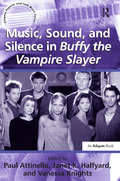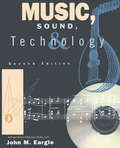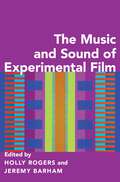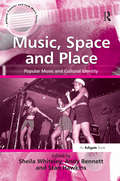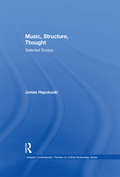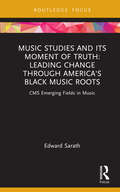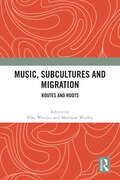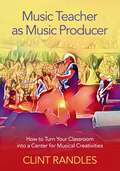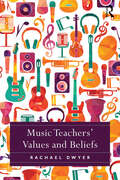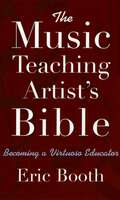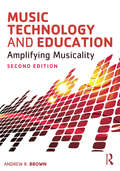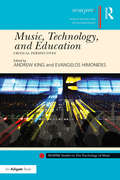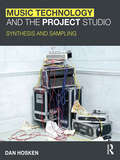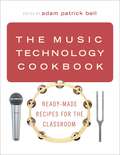- Table View
- List View
Music, Sound, and Silence in Buffy the Vampire Slayer (Ashgate Popular And Folk Music Ser.)
by JanetK. HalfyardThe intense and continuing popularity of the long-running television show Buffy the Vampire Slayer (1997-2003) has long been matched by the range and depth of the academic critical response. This volume, the first devoted to the show's imaginative and widely varied use of music, sound, and silence, helps to develop an increasingly important and inadequately covered area of research - the many roles of music in contemporary television. In addressing this significant gap, this book provides an exemplary overview of the functions of music and sound in the interpretation of a television show. This is done through analyses that focus on scoring and source music, the title theme, the music production process, the critically acclaimed musical episode (voted number 13 in Channel Four's One Hundred Greatest Musicals), the symbolic and dramatic use of silence, and the popular reception of the show by its international fan base. In keeping with contemporary trends in the study of popular musics, a variety of critical approaches are taken from musicology, cultural studies, and media and communication studies, specifically employing critique, musical analysis, industry studies, and hermeneutics.
Music, Sound, and Technology
by John M. EargleSince its publication in 1990, the first edition of Music, Sound, and Technology has enjoyed wide success and has become a popular text in musical acoustical studies at the university level. In preparing the new edition we have included recent developments in all aspects of music and sound technology, and we have added data on acoustical characteristics of musical in struments. The first edition has been cited for the scope and clarity of its graphics; we have emphasized this to an even greater degree in the second edition. /ME xi Preface to the First Edition This book is about music. the instruments and players who produce it. and the technologies that support it. Although much modern music is produced by electronic means. its underlying basis is still traditional acoustical sound production. and that broad topic provides the basis for this book. There are many fine books available that treat musical acoustics largely from the physical point of view. The approach taken here is to present only the fundamentals of musical phys ics. while giving special emphasis to the relation between instrument and player and stressing the characteristics of instruments that are of special concern to engineers and tech nicians involved in the fields of recording. sound reinforcement. and broadcasting. In order to understand musical instruments in their normal performance environments.
MUSIC & SOUND OF EXPERIMENTAL FILM C
by Holly Rogers and Jeremy BarhamThis book explores music/sound-image relationships in non-mainstream screen repertoire from the earliest examples of experimental audiovisuality to the most recent forms of expanded and digital technology. It challenges presumptions of visual primacy in experimental cinema and rethinks screen music discourse in light of the aesthetics of non-commercial imperatives. Several themes run through the book, connecting with and significantly enlarging upon current critical discourse surrounding realism and audibility in the fiction film, the role of music in mainstream cinema, and the audiovisual strategies of experimental film. The contributors investigate repertoires and artists from Europe and the USA through the critical lenses of synchronicity and animated sound, interrelations of experimentation in image and sound, audiovisual synchresis and dissonance, experimental soundscape traditions, found-footage film, re-mediation of pre-existent music and sound, popular and queer sound cultures, and a diversity of radical technological, aesthetic, tropes in film media traversing the work of early pioneers such as Walther Ruttmann and Len Lye, through the mid-century innovations of Norman McLaren, Stan Brakhage, Lis Rhodes, Kenneth Anger, Andy Warhol, and studio collectives in Poland, to latter-day experimentalists John Smith and Bill Morrison, as well as the contemporary practices of Vjing.
Music, Space and Place: Popular Music and Cultural Identity
by Andy BennettMusic, Space and Place examines the urban and rural spaces in which music is experienced, produced and consumed. The editors of this collection have brought together new and exciting perspectives by international researchers and scholars working in the field of popular music studies. Underpinning all of the contributions is the recognition that musical processes take place within a particular space and place, where these processes are shaped both by specific musical practices and by the pressures and dynamics of political and economic circumstances. Important discourses are explored concerning national culture and identity, as well as how identity is constructed through the exchanges that occur between displaced peoples of the world's many diasporas. Music helps to articulate a shared sense of community among these dispersed people, carving out spaces of freedom which are integral to personal and group consciousness. A specific focal point is the rap and hip hop music that has contributed towards a particular sense of identity as indigenous resistance vernaculars for otherwise socially marginalized minorities in Cuba, France, Italy, New Zealand and South Africa. New research is also presented on the authorial presence in production within the domain of the commercially driven Anglo-American music industry. The issue of authorship and creativity is tackled alongside matters relating to the production of musical texts themselves, and demonstrates the gender politics in pop. Underlying Music, Space and Place, is the question of how the disciplines informing popular music studies - sociology, musicology, cultural studies, media studies and feminism - have developed within a changing intellectual climate. The book therefore covers a wide range of subject matter in relation to space and place, including community and identity, gender, race, 'vernaculars', power, performance and production.
Music, Space and Place: Popular Music and Cultural Identity (Ashgate Popular And Folk Music Ser.)
by Andy BennettMusic, Space and Place examines the urban and rural spaces in which music is experienced, produced and consumed. The editors of this collection have brought together new and exciting perspectives by international researchers and scholars working in the field of popular music studies. Underpinning all of the contributions is the recognition that musical processes take place within a particular space and place, where these processes are shaped both by specific musical practices and by the pressures and dynamics of political and economic circumstances. Important discourses are explored concerning national culture and identity, as well as how identity is constructed through the exchanges that occur between displaced peoples of the world's many diasporas. Music helps to articulate a shared sense of community among these dispersed people, carving out spaces of freedom which are integral to personal and group consciousness. A specific focal point is the rap and hip hop music that has contributed towards a particular sense of identity as indigenous resistance vernaculars for otherwise socially marginalized minorities in Cuba, France, Italy, New Zealand and South Africa. New research is also presented on the authorial presence in production within the domain of the commercially driven Anglo-American music industry. The issue of authorship and creativity is tackled alongside matters relating to the production of musical texts themselves, and demonstrates the gender politics in pop. Underlying Music, Space and Place, is the question of how the disciplines informing popular music studies - sociology, musicology, cultural studies, media studies and feminism - have developed within a changing intellectual climate. The book therefore covers a wide range of subject matter in relation to space and place, including community and identity, gender, race, 'vernaculars', power, performance and production.
Music, Structure, Thought: Selected Essays
by James HepokoskiAmong the most original and provocative musicological writers of his generation, James Hepokoski has elaborated new paradigms of inquiry for both music history and music theory. Advocating fundamental shifts of methodological reorientation within the quest for potential musical meanings, his work spans both disciplines and offers substantial challenges for each. At its core is the conviction that a close study of musical genres, procedures, and structures those qualities of a composition that are specifically musical is essential to any responsible hermeneutic enterprise. Selected from writings from 1984 to 2008, this collection of essays provides a generous introduction to the author‘s most innovative and influential work on a wide variety of topics: musicological methodology, issues of staging and performance, Italian opera, program music, and exemplary studies of individual pieces.
Music, Structure, Thought: Selected Essays
by James HepokoskiAmong the most original and provocative musicological writers of his generation, James Hepokoski has elaborated new paradigms of inquiry for both music history and music theory. Advocating fundamental shifts of methodological reorientation within the quest for potential musical meanings, his work spans both disciplines and offers substantial challenges for each. At its core is the conviction that a close study of musical genres, procedures, and structures those qualities of a composition that are specifically musical is essential to any responsible hermeneutic enterprise. Selected from writings from 1984 to 2008, this collection of essays provides a generous introduction to the author‘s most innovative and influential work on a wide variety of topics: musicological methodology, issues of staging and performance, Italian opera, program music, and exemplary studies of individual pieces.
Music Studies and Its Moment of Truth: CMS Emerging Fields in Music (CMS Emerging Fields in Music)
by Edward SarathMusic Studies and Its Moment of Truth: Leading Change through America’s Black Music Roots presents a new framework for racial justice discourse in the context of music studies and education. Centering on Black American Music, the book issues challenges to both the conventional music studies paradigm and decades-old reform efforts.While Black American Music ranks high among America’s contributions to world culture, and offers musicians powerful tools for musical practice and understanding, this musical legacy remains remarkably marginalized even in activist conversations. The author argues that this reflects lingering and unexamined racist patterns that persist even among the most fervent voices for anti-racist interventions, and addresses the need for a higher-order activist framework within music studies.Delving further into the transformative changes needed to pursue racial justice, the short pieces collected in this book discuss topics including a shift from multicultural ideology to a transcultural model of musical pluralism, analysis of the multi-tiered nature of musical racism, the whitewashing of music studies activism, K-12 music teacher education as the locus for paradigmatic change and the potential for a transformed model of music studies to catalyze an overarching revolution in creativity and consciousness in both education and society at large. Critiquing the failures of progressive reform efforts and conventional reaction, this book argues that major changes are needed to the discourse on racism in music studies, and envisions new paradigms for the future.
Music Studies and Its Moment of Truth: CMS Emerging Fields in Music (CMS Emerging Fields in Music)
by Edward SarathMusic Studies and Its Moment of Truth: Leading Change through America’s Black Music Roots presents a new framework for racial justice discourse in the context of music studies and education. Centering on Black American Music, the book issues challenges to both the conventional music studies paradigm and decades-old reform efforts.While Black American Music ranks high among America’s contributions to world culture, and offers musicians powerful tools for musical practice and understanding, this musical legacy remains remarkably marginalized even in activist conversations. The author argues that this reflects lingering and unexamined racist patterns that persist even among the most fervent voices for anti-racist interventions, and addresses the need for a higher-order activist framework within music studies.Delving further into the transformative changes needed to pursue racial justice, the short pieces collected in this book discuss topics including a shift from multicultural ideology to a transcultural model of musical pluralism, analysis of the multi-tiered nature of musical racism, the whitewashing of music studies activism, K-12 music teacher education as the locus for paradigmatic change and the potential for a transformed model of music studies to catalyze an overarching revolution in creativity and consciousness in both education and society at large. Critiquing the failures of progressive reform efforts and conventional reaction, this book argues that major changes are needed to the discourse on racism in music studies, and envisions new paradigms for the future.
Music, Subcultures and Migration: Routes and Roots
by Elke Weesjes Matthew WorleyThis edited volume concentrates on the period from the 1940s to the present, exploring how popular music forms such as blues, disco, reggae, hip hop, grime, metal and punk evolved and transformed as they traversed time and space. Within this framework, the collection traces how music and subcultures travel through, to and from democracies, autocracies and anocracies.The chosen approach is multidisciplinary and deliberately diverse. Using both archival sources and oral testimony from a wide variety of musicians, promoters, critics and members of the audience, contributors from a range of academic disciplines explore music and subcultural forms in countries across Asia, Europe, Oceania, North America and Africa. They investigate how far the meaning of music and associated subcultures change as they move from one context to another and consider whether they transcend or blur parameters of class, race, gender and sexuality.
Music, Subcultures and Migration: Routes and Roots
This edited volume concentrates on the period from the 1940s to the present, exploring how popular music forms such as blues, disco, reggae, hip hop, grime, metal and punk evolved and transformed as they traversed time and space. Within this framework, the collection traces how music and subcultures travel through, to and from democracies, autocracies and anocracies.The chosen approach is multidisciplinary and deliberately diverse. Using both archival sources and oral testimony from a wide variety of musicians, promoters, critics and members of the audience, contributors from a range of academic disciplines explore music and subcultural forms in countries across Asia, Europe, Oceania, North America and Africa. They investigate how far the meaning of music and associated subcultures change as they move from one context to another and consider whether they transcend or blur parameters of class, race, gender and sexuality.
Music Teacher as Music Producer: How to Turn Your Classroom into a Center for Musical Creativities
by Clint RandlesNever has there been such an exciting time to be a music teacher. Band, choir, and orchestra are ubiquitous in schools and have come to be known as the primary mode that students experience music at the secondary level. Similarly, elementary school classrooms feature approaches by Orff, Kodaly, Dalcroze, and Music Learning Theory, among a host of others. But, what is next? In this enlightening guide, author Clint A. Randles provides music educators with the practical tools to turn their classrooms into student production studios. Addressing everything from a new conceptualization of the physical classroom space to the cables and other audio equipment no music educator should be without, Randles puts creativity, technology, recording arts, songwriting, music production, and live performance at the center of music classrooms.
Music Teacher as Music Producer: How to Turn Your Classroom into a Center for Musical Creativities
by Clint RandlesNever has there been such an exciting time to be a music teacher. Band, choir, and orchestra are ubiquitous in schools and have come to be known as the primary mode that students experience music at the secondary level. Similarly, elementary school classrooms feature approaches by Orff, Kodaly, Dalcroze, and Music Learning Theory, among a host of others. But, what is next? In this enlightening guide, author Clint A. Randles provides music educators with the practical tools to turn their classrooms into student production studios. Addressing everything from a new conceptualization of the physical classroom space to the cables and other audio equipment no music educator should be without, Randles puts creativity, technology, recording arts, songwriting, music production, and live performance at the center of music classrooms.
Music Teachers' Values and Beliefs
by Rachael DwyerIn Music Teachers' Values and Beliefs, Dwyer investigates the relationships between teachers, learners and music in music classrooms. Using Bourdieu's concepts of habitus and doxa as an interpretive lens, the book explores the values and beliefs of four music teachers, depicted in richly detailed narratives. The narratives are contextualised through the examination of traditions of music and contemporary approaches. In the past, music education has been shaped by elitist tendencies regarding the types of music worthy of study, the ways in which music should be learnt, and the purpose of such learning. Contemporary approaches to music education have enacted significant change in some regions and systems, while others have been slower to leave behind deeply entrenched values, beliefs and practices. These approaches have been blamed for low rates of participation and engagement in school music education, despite the fact that the majority of young people listen to and enjoy music outside of school. This innovative book provides music education researchers and practitioners with a new understanding of the impact of teachers' personal values, beliefs and experiences of music and music education on classroom practice, and the impact this has on students' experiences of music education.
Music Teachers' Values and Beliefs
by Rachael DwyerIn Music Teachers' Values and Beliefs, Dwyer investigates the relationships between teachers, learners and music in music classrooms. Using Bourdieu's concepts of habitus and doxa as an interpretive lens, the book explores the values and beliefs of four music teachers, depicted in richly detailed narratives. The narratives are contextualised through the examination of traditions of music and contemporary approaches. In the past, music education has been shaped by elitist tendencies regarding the types of music worthy of study, the ways in which music should be learnt, and the purpose of such learning. Contemporary approaches to music education have enacted significant change in some regions and systems, while others have been slower to leave behind deeply entrenched values, beliefs and practices. These approaches have been blamed for low rates of participation and engagement in school music education, despite the fact that the majority of young people listen to and enjoy music outside of school. This innovative book provides music education researchers and practitioners with a new understanding of the impact of teachers' personal values, beliefs and experiences of music and music education on classroom practice, and the impact this has on students' experiences of music education.
The Music Teaching Artist's Bible: Becoming a Virtuoso Educator
by Eric BoothWhen the artist moves into the classroom or community to educate and inspire students and audience members, this is Teaching Artistry. It is a proven means for practicing professional musicians to create a successful career in music, providing not only necessary income but deep and lasting satisfaction through engaging people in learning experiences about the arts. Filled with practical advice on the most critical issues facing the music teaching artist today--from economic and time-management issues of being a musician and teacher to communicating effectively with students--The Music Teaching Artist's Bible uncovers the essentials that every musician needs in order to thrive in this role. Author Eric Booth offers both inspiration and how-to, step-by-step guidance in this truly comprehensive manual that music teaching artists will turn to again and again. The book also includes critical information on becoming a mentor, succeeding in school environments, partnering with other teaching artists, advocating for music and arts education, and teaching private lessons. The Music Teaching Artist's Bible helps practicing and aspiring teaching artists gain the skills they need to build new audiences, improve the presence of music in schools, expand the possibilities of traditional and educational performances, and ultimately make their lives as an artists even more satisfying and fulfilling.
The Music Teaching Artist's Bible: Becoming a Virtuoso Educator
by Eric BoothWhen the artist moves into the classroom or community to educate and inspire students and audience members, this is Teaching Artistry. It is a proven means for practicing professional musicians to create a successful career in music, providing not only necessary income but deep and lasting satisfaction through engaging people in learning experiences about the arts. Filled with practical advice on the most critical issues facing the music teaching artist today--from economic and time-management issues of being a musician and teacher to communicating effectively with students--The Music Teaching Artist's Bible uncovers the essentials that every musician needs in order to thrive in this role. Author Eric Booth offers both inspiration and how-to, step-by-step guidance in this truly comprehensive manual that music teaching artists will turn to again and again. The book also includes critical information on becoming a mentor, succeeding in school environments, partnering with other teaching artists, advocating for music and arts education, and teaching private lessons. The Music Teaching Artist's Bible helps practicing and aspiring teaching artists gain the skills they need to build new audiences, improve the presence of music in schools, expand the possibilities of traditional and educational performances, and ultimately make their lives as an artists even more satisfying and fulfilling.
Music Technology and Education: Amplifying Musicality
by Andrew BrownMusic Technology in Education lays out the principles of music technology and how they can be used to enhance musical teaching and learning in primary and secondary education. Previously published as Computers in Music Education, this second edition has been streamlined to focus on the needs of today’s music education student. It has been completely updated to reflect mobile technologies, social networks, rich media environments, and other technological advances. Topics include: Basic audio concepts and recording techniques Enhanced music instruction with interactive systems, web-based media platforms, social networking, and musicianship software Administration and management of technology resources Distance education and flexible learning Music Technology in Education provides a strong theoretical and philosophical framework for examining the use of technology in music education while outlining the tools and techniques for implementation in the classroom. Reflective Questions, Teaching Tips, and Suggested Tasks link technology with effective teaching practice. The companion website provides resources for deeper investigation into the topics covered in each chapter, and includes an annotated bibliography, website links, tutorials, and model projects.
Music Technology and Education: Amplifying Musicality
by Andrew BrownMusic Technology in Education lays out the principles of music technology and how they can be used to enhance musical teaching and learning in primary and secondary education. Previously published as Computers in Music Education, this second edition has been streamlined to focus on the needs of today’s music education student. It has been completely updated to reflect mobile technologies, social networks, rich media environments, and other technological advances. Topics include: Basic audio concepts and recording techniques Enhanced music instruction with interactive systems, web-based media platforms, social networking, and musicianship software Administration and management of technology resources Distance education and flexible learning Music Technology in Education provides a strong theoretical and philosophical framework for examining the use of technology in music education while outlining the tools and techniques for implementation in the classroom. Reflective Questions, Teaching Tips, and Suggested Tasks link technology with effective teaching practice. The companion website provides resources for deeper investigation into the topics covered in each chapter, and includes an annotated bibliography, website links, tutorials, and model projects.
Music, Technology, and Education: Critical Perspectives (SEMPRE Studies in The Psychology of Music)
by Andrew King Evangelos HimonidesThe use of technology in music and education can no longer be described as a recent development. Music learners actively engage with technology in their music making, regardless of the opportunities afforded to them in formal settings. This volume draws together critical perspectives in three overarching areas in which technology is used to support music education: music production; game technology; musical creation, experience and understanding. The fourteen chapters reflect the emerging field of the study of technology in music from a pedagogical perspective. Contributions come not only from music pedagogues but also from musicologists, composers and performers working at the forefront of the domain. The authors examine pedagogical practice in the recording studio, how game technology relates to musical creation and expression, the use of technology to create and assess musical compositions, and how technology can foster learning within the field of Special Educational Needs (SEN). In addition, the use of technology in musical performance is examined, with a particular focus on the current trends and the ways it might be reshaped for use within performance practice. This book will be of value to educators, practitioners, musicologists, composers and performers, as well as to scholars with an interest in the critical study of how technology is used effectively in music and music education.
Music, Technology, and Education: Critical Perspectives (SEMPRE Studies in The Psychology of Music)
by Andrew King Evangelos HimonidesThe use of technology in music and education can no longer be described as a recent development. Music learners actively engage with technology in their music making, regardless of the opportunities afforded to them in formal settings. This volume draws together critical perspectives in three overarching areas in which technology is used to support music education: music production; game technology; musical creation, experience and understanding. The fourteen chapters reflect the emerging field of the study of technology in music from a pedagogical perspective. Contributions come not only from music pedagogues but also from musicologists, composers and performers working at the forefront of the domain. The authors examine pedagogical practice in the recording studio, how game technology relates to musical creation and expression, the use of technology to create and assess musical compositions, and how technology can foster learning within the field of Special Educational Needs (SEN). In addition, the use of technology in musical performance is examined, with a particular focus on the current trends and the ways it might be reshaped for use within performance practice. This book will be of value to educators, practitioners, musicologists, composers and performers, as well as to scholars with an interest in the critical study of how technology is used effectively in music and music education.
Music Technology and the Project Studio: Synthesis and Sampling
by Dan HoskenMusic Technology and the Project Studio: Synthesis and Sampling provides clear explanations of synthesis and sampling techniques and how to use them effectively and creatively. Starting with analog-style synthesis as a basic model, this textbook explores in detail how messages from a MIDI controller or sequencer are used to control elements of a synthesizer to create rich, dynamic sound. Since samplers and sample players are also common in today’s software, the book explores the details of sampling and the control of sampled instruments with MIDI messages. This book is not limited to any specific software and is general enough to apply to many different software instruments. Overviews of sound and digital audio provide students with a set of common concepts used throughout the text, and "Technically Speaking" sidebars offer detailed explanations of advanced technical concepts, preparing students for future studies in sound synthesis. Music Technology and the Project Studio: Synthesis and Sampling is an ideal follow-up to the author’s An Introduction to Music Technology, although each book can be used independently. The Companion Website includes: Audio examples demonstrating synthesis and sampling techniques Interactive software that allows the reader to experiment with various synthesis techniques Guides relating the material in the book to various software synthesizers and samplers Links to relevant resources, examples, and software
Music Technology and the Project Studio: Synthesis and Sampling
by Dan HoskenMusic Technology and the Project Studio: Synthesis and Sampling provides clear explanations of synthesis and sampling techniques and how to use them effectively and creatively. Starting with analog-style synthesis as a basic model, this textbook explores in detail how messages from a MIDI controller or sequencer are used to control elements of a synthesizer to create rich, dynamic sound. Since samplers and sample players are also common in today’s software, the book explores the details of sampling and the control of sampled instruments with MIDI messages. This book is not limited to any specific software and is general enough to apply to many different software instruments. Overviews of sound and digital audio provide students with a set of common concepts used throughout the text, and "Technically Speaking" sidebars offer detailed explanations of advanced technical concepts, preparing students for future studies in sound synthesis. Music Technology and the Project Studio: Synthesis and Sampling is an ideal follow-up to the author’s An Introduction to Music Technology, although each book can be used independently. The Companion Website includes: Audio examples demonstrating synthesis and sampling techniques Interactive software that allows the reader to experiment with various synthesis techniques Guides relating the material in the book to various software synthesizers and samplers Links to relevant resources, examples, and software
The Music Technology Cookbook: Ready-Made Recipes for the Classroom
Featuring 56 lessons by 49 music technology experts from around the world, The Music Technology Cookbook is an all-in-one guide to the world of music technology, covering topics like: composition (with digital audio workstations such as Ableton, Soundtrap, GarageBand); production skills such as recording, editing, and equalization; creating multimedia (ringtones, soundscapes, audio books, sonic brands, jingles); beatmaking; DJing; programming (Minecraft, Scratch, Sonic Pi, P5.js); and, designing instruments (MaKey MaKey). Each lesson tailored for easy use and provides a short description of the activity, keywords, materials needed, teaching context of the contributing author, time required, detailed instructions, modifications for learners, learning outcomes, assessment considerations, and recommendations for further reading. Music educators will appreciate the book's organization into five sections--Beatmaking and Performance; Composition; Multimedia and Interdisciplinary; Production; Programming--which are further organized by levels beginner, intermediate, and advanced. Written for all educational contexts from community organizations and online platforms to universities and colleges, The Music Technology Cookbook offers a recipe for success at any level.
MUSIC TECHNOLOGY COOKBOOK C: Ready-Made Recipes for the Classroom
by Adam Patrick BellFeaturing 56 lessons by 49 music technology experts from around the world, The Music Technology Cookbook is an all-in-one guide to the world of music technology, covering topics like: composition (with digital audio workstations such as Ableton, Soundtrap, GarageBand); production skills such as recording, editing, and equalization; creating multimedia (ringtones, soundscapes, audio books, sonic brands, jingles); beatmaking; DJing; programming (Minecraft, Scratch, Sonic Pi, P5.js); and, designing instruments (MaKey MaKey). Each lesson tailored for easy use and provides a short description of the activity, keywords, materials needed, teaching context of the contributing author, time required, detailed instructions, modifications for learners, learning outcomes, assessment considerations, and recommendations for further reading. Music educators will appreciate the book's organization into five sections--Beatmaking and Performance; Composition; Multimedia and Interdisciplinary; Production; Programming--which are further organized by levels beginner, intermediate, and advanced. Written for all educational contexts from community organizations and online platforms to universities and colleges, The Music Technology Cookbook offers a recipe for success at any level.
